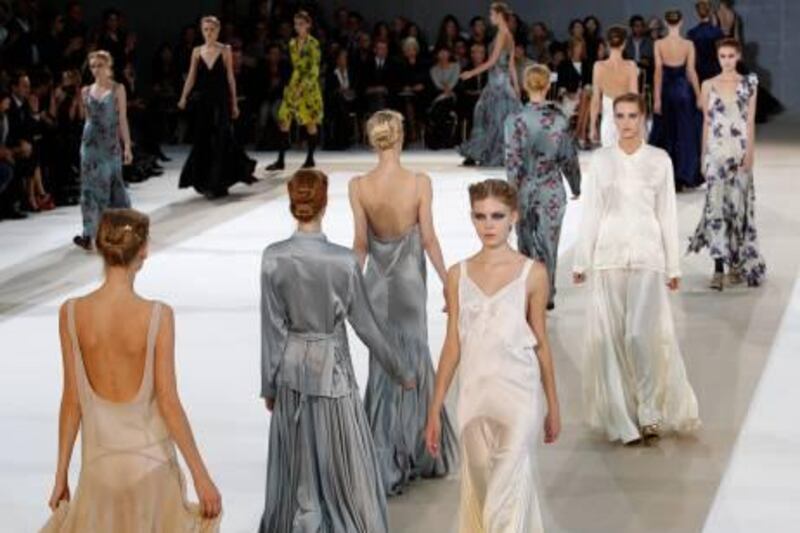There's a sense of carefree optimism at Paris Fashion Week. The spring/summer 2011 shows thus far have been upbeat, relaxed and confident in a way that we have not enjoyed for some seasons. Thursday saw Anne Valérie Hash pursue a luminously neutral palette and almost-classic shapes, all slightly tweaked - low-rise trousers cut voluminously and twisted to one side, simple dresses accented with fray-edged ruffles - and sent out to a soundtrack of twisted covers by the blues-folk singer Gemma Ray, a high point in a week in which the shows' music was as telling as the clothes themselves.
Video: M Magazine Paris Fashion Shoot
The idea, the location, the clothes, the model, the photographer, the cover shot- It doesn't just happen on it's own. Katie Trotter, Fashion Editor, takes us behind the planning of M's fashion shoot in Paris. The theme? The charm of the orient.
[ Watch this video in full screen here ]
Take Dries Van Noten, he of the traditional crafts, ethnic prints and easy-to-wear shapes. This season, he went bright and white to the sound of Florence & the Machine's The Dog Days Are Over: the message could not have been clearer. This was a gorgeous, positive collection with techno fabrics featuring silver foiling, holographic weaves and iridescent sequins, softening into his trademark fluid silks in dip-dye grey dresses with tropical flower prints and gradations of colour so subtle they could have been a trick of the light. The only misfires were the men's oversized jackets, which felt like a slightly gimmicky and uncharacteristic concession to seasonal fads.
A little later the same day, Marco Zanini at Rochas sent out a series of bluestocking eccentrics in ravishing prints and shapes. Particularly fine were the fantastical floating rococo skirts, with their panniers and panelled prints. The colours were like a sultry summer storm: purple, acid yellow, teal, mustard, blue. More significant was the dropped waist on several of the pretty minidresses, worn with knee socks, flat shoes and bucket hats. After a couple of seasons in which a tiny waist has been the focal point, this descent to the hips looked very fresh, especially on the glorious 1930s-style white silk evening gowns, gently panelled to the pelvis and luxuriantly rippling to the floor.
Barbara Bui relaxed the torso as well, eschewing her usual high-octane leather for wearable washed silks, suede and mesh, and some beautifully fitted biker jackets embellished in tribal patterns. On the walk to the Vionnet presentation, in Rue Charlot, was the Société des Chaînes du Marais, an old-fashioned shop with windows filled with gold chains of various sorts. It was interesting, moments later, to see Rodolfo Paglialunga's light-as-air fabrics anchored with chain after chain: strips of silk and poplin were looped through gold or black links at the neck and waist, gathered and released to create pretty, flattering frocks with a French Riviera feel that is very different from the dark, smoky luxury of last season. Here, too, were dropped waists, in crêpe silks and chiffons that were intricately cut and expertly folded and ruffled into deceptively simple, short dresses, the palette featuring creamy white, black, red and soft pastels - yellow, pink, cornflower, marl grey.
The basket-soled shoes, part of the label's collaboration with Giuseppe Zanotti, looked like very upmarket espadrilles, and the gold star and leaf motifs used on belts and headbands came courtesy of the Vionnet archives. Waists weren't even an option at Issey Miyake, but colour was. Dai Fujiwara's ethereal opening shifts, with three-dimensional elliptical pleating and cocoon-like structures, soon gave way to clear, bright hues. After a mystifying detour into rock-chick-meets-Pleats-Please territory, the final black and white robes, in bouncing pleats, were a delight.
And so to Dior and Lanvin, two giants on the same day, both helmed by designers who know just how to play a crowd. John Galliano's witty take on the South Pacific sailor - jaunty white sailor hats, wide blue trousers, pea coats over devastatingly pretty whisps of bright silk, and floral garlands - was approachable and wearable. There was still plenty of glamour, particularly in the eveningwear, which came in pure pigment shades of violet, pink and yellow chiffon, cut low and flowing from the hips, and embellished as if designed specifically for the Middle East.
Lanvin started more than an hour late, yet still managed to provoke the crowd into spontaneous bursts of applause during the show. The first dark, almost wintery fabrics, albeit exquisitely cut, were an inauspicious start, but it turned out Alber Elbaz was just kidding around: a sudden burst of colour with an ultra-feminine, floating pink and orange ensemble switched the mood, the energy was maintained with sporty neon horizontally pleated dresses and tops, as well as that all-important drop-waisted mini, and by the time he took his bow, the stern fashionistas were clapping along to the splendid Viola Wills disco version of Always Something There to Remind Me. After that, even the grey, gloomy damp of the Halles Freyssinet venue couldn't rain on Paris Fashion Week's parade.





